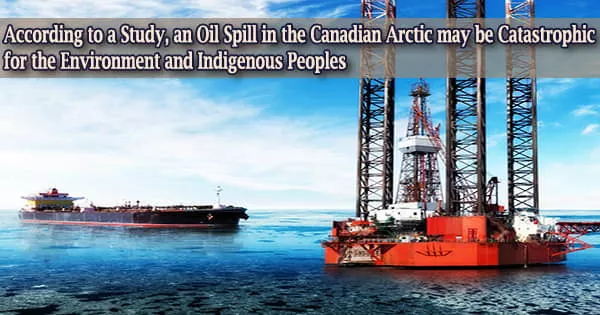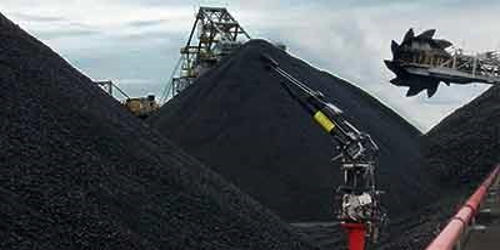The Northwest Passage (NWP) has become increasingly accessible to shipping, raising the possibility of an oil spill and other environmental catastrophes as a result of the Arctic ice sheet melting at a faster rate as a result of rising global temperatures.
An oil spill in the Canadian Arctic, according to recent research published in the journal Risk Analysis, may be disastrous, especially for vulnerable indigenous people.
“Infrastructure along the NWP in Canada’s Arctic is almost non-existent. This presents major challenges to any response efforts in the case of a natural disaster,” says Mawuli Afenyo, lead author, University of Manitoba researcher, and expert on the risks of Arctic shipping.
An oil spill is a type of pollution that occurs when a liquid petroleum hydrocarbon is released into the environment, particularly the marine ecology. Oil releases into the sea or coastal waterways are generally referred to as marine oil spills, however, land-based spills are also possible.
Afenyo and his coworkers have created a brand-new technique that may aid managers in anticipating the risk of pollution from increased shipping activities. The study details how they applied it to evaluate the socioeconomic effects of a hypothetical oil leak in the Canadian Arctic’s Rankin Inlet region.
The importance of this area as a regional maritime hub for the Arctic has increased since 2010. The 1989 Exxon Valdez tragedy, in which an oil tanker spilled 11 million gallons of oil into Alaska’s Prince William Sound, was modelled by the researchers for their investigation.
It should be noted that the Rankin Inlet has not had an oil leak of the same size as the Exxon Valdez; this study is a simulation to predict the potential effects of such a spill.
“One of our key findings was that the negative socio-economic impact of an oil spill in the Arctic accelerates quickly with time if there is no intervention,” says Afenyo. “Our study also showed that an oil spill in this region has serious social impacts affecting the family dynamics, hunting traditions, and culture of vulnerable indigenous communities.”
In the 1960s, oil spills in the ocean became a significant environmental issue, mostly as a result of increased petroleum exploration and production on continental shelves and the usage of supertankers that could carry more than 500,000 metric tons of oil.
One of our key findings was that the negative socio-economic impact of an oil spill in the Arctic accelerates quickly with time if there is no intervention. Our study also showed that an oil spill in this region has serious social impacts affecting the family dynamics, hunting traditions, and culture of vulnerable indigenous communities.
Mawuli Afenyo
Oil spills can result from crude oil discharges from tankers, offshore platforms, drilling rigs, and wells as well as refined petroleum products (like gasoline and diesel) and their byproducts, heavier fuels used by big ships like bunker fuel, or the spill of any oily waste or garbage.
However, there are thousands of minor and a few big oil spills due to well discharges and tanker operations reported every year, with an annual total of more than one million metric tons of oil dumped into the world’s oceans.
Due to the severe environment and isolation of the area, cleaning up a spill in the Arctic differs from that in other oceanic regions. An oil leak can cause it to flow beneath the ice, between the ice, absorb into the snow, and get trapped in the ice.
This makes long-term monitoring and response operations challenging and expensive. The researchers assessed the likelihood and effects of an oil spill in the Rankin Inlet using two alternative risk assessment models.
They interviewed scientists, government employees, insurance experts, and owners of rights who reside or work in the Arctic in order to determine the probability. They also looked back at previous occurrences and scientific publications regarding oil spills.
They employed a multi-period model to forecast the socio-economic effects over a five-year period in the event that no recovery attempts were made, which is one of the most likely scenarios for this region based on present conditions, in order to evaluate the effects of a spill.
“This worse-case scenario analysis gives decision-makers the opportunity to put into place intervention that will help mitigate risks to a bare minimum,” Afenyo explained.
An influence diagram was created to include all potential spill-related effects and aid managers in determining the risk of a spill in terms of dollars. It includes effects like the extinction of plants and animals as well as the disturbance of hunting and culture for the local indigenous populations.
The cost with no intervention was expected to be $500 million in the first year after the spill in the Rankin Inlet. This amount increased to $7.5 billion by the fifth year.
“Our method is very comprehensive as it uses both qualitative and quantitative inputs and can be used to assess not only the socio-economic impacts but also the environmental consequences,” says Afenyo.
He continues by saying that it can be used as a tool for policymakers, insurance providers, and government agencies in charge of risk assessment and disaster response.
The researchers’ analysis revealed a pressing need for the creation of an effective communication network between the region’s indigenous peoples, the Canadian government, and businesses seeking to do business there.
“The challenge will be determining how the Canadian federal government should collaborate with indigenous people to respond rapidly to an oil spill,” says Afenyo.
The team wants to investigate how different policy approaches could reduce the detrimental effects of such accidents in the Arctic and build an app to assist decision-makers in assessing the socio-economic implications of shipping disasters there.
This would aid maritime insurers in creating useful instruments that would make it easier to precisely estimate risk and insurance premiums for ships transiting the Arctic. The recently built Churchill Marine Observatory will be a crucial source of information to further increase the model’s accuracy.
The paper is co-authored by Changmin Jiang of the Asper School of Business at the University of Manitoba and Adolf K.Y. Ng in the Division of Business and Management at Beijing Normal University-Hong Kong Baptist University United International College (China).
The joint Sino-Canadian research is part of the GENICE project (Microbial Genomics for Oil Spill Preparedness in Canada’s Arctic Marine Environment) led by the University of Manitoba and the University of Calgary.
















